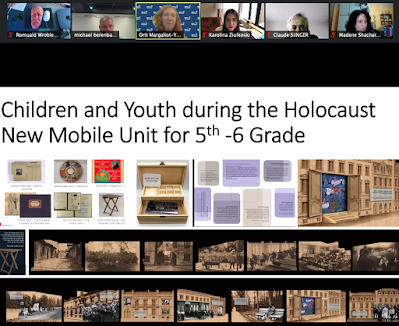 |
| Förintelsen - sönderslaget porslin i gammalt skåp |
 |
Förintelsen - sönderslaget porslin i gammalt skåp och artefakter
|

I ett par timmar idag så deltog jag i International Conference Marking the 25th Anniversary of Yad LaYeled i Israel "The Jewish Child during and after the Holocaust: Research and Pedagogy in a Changing World".
Ett antal forskare och chefer for Förintelsemuseer talade om hur de lär ut "Förintelsen". Det fanns massa artefakter man visade men inte FÖRINTELSEN. Man visade väskor, dagböcker, Davidsstjärnor och tiden före och efter egentliga FÖRINTELSEN.
På samma sätt som i Sverige skulle tycka synd om hunden Bobo, en docka Dolly eller en annan älskad leksak eller en avsaknad av ett föräldrahem med vackra gardiner.
Själv har inte eget svar hur man skall visa Förintelsen utan hungriga barn i getton, boskapsvagnar och de mördade i massgravar.
Det gäller HUR man skall lära och vad? Det känns att man numera, nästan som inom sexualundervisningen på 50-talet, undviker att tala om MÖRDANDET: Både det som skedde efter aktionen Barbarossa med massavrättningarna vid massgravarna och det industriella mördandet i dödsfabriker som Treblinka och Auschwitz. De lämnade ensamma hemma, dockan Dolly och hunden Bobo, kan inte och kommer inte att ersätta informationen om den råa verkligheten. Samma sak gäller beskrivningarna av livet i getton. På 50-talet har frågor kring kropp och sexualitet förklarats med blommor och bin utan att nämna en snopp eller en snippa. Nu, 76 år efter att Förintelsen tog slut undviker man på samma sätt ämnet Hur de 6 000 000 judar dog. Endast med en sund och verklighetstrogen inställning till Förintelsen kan man tackla det faktum att det är 76 år efter att den mörka perioden tog slut. Numera fler barn redan i de första klasserna stöter på mord sex och våld både i TV-rutan och i det verkliga livet i Sverige.
15:30 – 15:45 | Opening remarks: Yigal Cohen, CEO Ghetto Fighters' House Dr. Boaz Cohen, Head of the Holocaust Studies Program, Western Galilee Academic College Ada Tuchbant, President, Yad LaYeled France Madene Shachar, Yad LaYeled |
15:45 – 16:45 | Keynote Speaker: Prof. Zehavit Gross Chairholder of the UNESCO/Burg Chair in Education for Human Values, Tolerance and Peace, and Head of the graduate program of Management and Development in Informal Education Systems at the School of Education, Bar-Ilan University, Israel Reflective Culture of Holocaust Remembrance (RCoHR): International Perspectives on Challenges and Ramifications |
16:45 - 17:00 | Short Break |
17:00 - 18:00 | The Jewish Child during the Holocaust: New Perspectives in Research Chair: Dr. Boaz Cohen The Yellow Star – Tagging Children and Teenagers during the Holocaust Dr. Verena Buser – Potsdam University of Applied Sciences and Western Galilee College Akko: Children of War, Holocaust and Genocide Project Jewish Child Survivors in the Centre of the Reconstruction of Jewish Families in the Aftermath of the Holocaust Prof. Joanna Michlic – Honorary Senior Research Associate at the UCL Centre for the Study of Collective Violence, the Holocaust and Genocide, UCL Institute for Advanced Studies |
18:00-18:30 | Break |
18:30 – 19:45 | International Roundtable: Holocaust Education in Museums and by Museums: Moderator: Dr. Michael Berenbaum, Professor of Jewish Studies and Director of the Sigi Ziering Institute: Exploring the Ethical and Religious Implications of the Holocaust, American Jewish University, USA · Tali Nates – Founding Director, Johannesburg Holocaust & Genocide Center, South Africa · Dr. Claude Singer, Director, Pedagogical Department, Memorial de la Shoah, France · Marc Cave, Director, National Holocaust Center & Museum, England · Karolina Ziulkoski, Chief Curator, YIVO Bruce and Francesca Cernia Slovin Online Museum, USA · Orit Margaliot, Head of Guide Training, Professional Development and Curricula at the Educational Guiding Department, ISHS, Yad Vashem, Israel · Madene Shachar, Senior Educator, Yad LaYeled Children's Memorial Museum, Israel |
19:45 – 20:00 | Closing Remarks Madene Shachar |



















